Posted on July 17 2020

Cycling Prague, Berlin, Frankfurt, Prague.
When the time is right, we will travel again with our bikes.
The planned bike tour for 2020 was cancelled because of you know what! We will keep this trip on hold for when we are able to do it post COVID-19 and we are free to travel once again. We are posting it here to hold ourselves to completing it in the future and to allow for extra research to be gathered.
We were due to fly in to Prague on 20th May 2020 with our trusted road bikes M1 & M2. Our cycling tour was to take in a circuit route from Prague-Dresden-Berlin-Frankfurt-Sonthofen-Prague, with two train sections in the middle.
The planning was a good exercise, one that we warm to when the trip is a good one…. a bit like getting into a good book, the plot has to thicken. Each trip is different, however for us there must be a reason, which dictates the planning and what we take and how we do it.
Following our own 13 step guide to planning a bike tour our first step was to have a theme or reason for our trip. Answering the "Why?".
Why: Our reason for choosing this route is family history and an Olympic link with 2020 due to be an Olympic year. Jen’s Mum, Katharine Connal, competed in the 1936 Berlin Olympics and again spent time in Germany immediately after World War II as part of the Control Commission of Germany (British Element), based in Berlin during the Berlin Blockade and later in Frankfurt where she met the love of her life. Jen’s father, Jaroslav Stuchlý, also spent time in Germany after WWII with his role of heading the CIO’s (Czechoslovak Intelligence Office) branch in Frankfurt and later in Austria during the Cold War and working with his contacts behind the iron curtain in the then Czechoslovakia. Frankfurt was the start of a family love affair where these two people met.
Destinations included more time in our beloved Prague, Dresden, Berlin, the Berlin Stadium, the Berlin wall (both Jen & Greg had visited Berlin prior to the downing of the wall in 1989 and have memories of crossing through Check Point Charlie into what was then East Berlin), Frankfurt, and Sonthofen where we have friends, then the route over the German-Czech border which was the undercover crossing for Jen’s Dad when he was working in surveillance during the Cold War.
 |
| Prague - we never tire of exploring this beautiful city. |
 |
We planned daily based on distances for riding, rests in places of interest and our history, and the terrain profile. Our bike bags and some extra clothes we were to leave at our bike friendly hotel in Prague, but for the travel time between we were to carry all our clothes & gear in the front roll bag, frame and seat post bags.
We will continue to add further research to this plan on the destinations and our particular interests. We encourage those who have travelled any of this route to add comments below with any recommendations of things or places to visit.
Each day of cycling has been mapped out using Komoot to create a route. If you are interested in the links for the rides contact us.
In the planning phase, as we research each place we record notes of things we want to see - this then reminds us and also acts as a basis for our completed notes of the trip with bits of history and background information added in. Some tours and events need to be pre booked or we need to be aware of which days certain venues are open. We find it helps to prepare us for our visit with some basic information which then gets padded out when we actually visit. If you follow this through you will see the notes for the first part of the trip are quite detailed and the latter part of the trip had few planning notes apart from the distance and route to take. We often continue our research whilst touring or prior to departure.
The plan for this trip sometime in the future post COVID-19:
Where: Perth, Prague, Dresden, Berlin, Frankfurt, Sonthofen, Prague, Perth.
How Long & When: Away for a total of 6 weeks. We had planned to leave on 20th May 2020. We have since added some extra days to the original plan. Northern Hemisphere late spring and early summer prior to European school summer holidays. It can still be cool, hopefully not too much rain and probably avoid any real heat. This has previously proved to be a good time to travel to these areas. Good deals on Airfares and accommodation is not booked out.
Who with: We travel as a couple. We had invited a number of other local cyclists to join us and our friend Yvonne took up the challenge and was excited about the trip. Like us she had booked her airfares and was getting organised to join us. We were doing all the bookings and arranging the tour. Accommodation had been booked for the first part of the tour. Fortunately Qatar Airways refunded all our airfares and by using Bookings.com we were able to cancel all our booked accommodation.
Day 1 Arrive Prague, Czech Republic.
Flights from Perth with Qatar Airways (we have flown with them several times before with our bikes. 30kg luggage allowance. Usually have good deals. Doha is a bright new airport.
Arrive Prague 1.10pm 21st May 2020. Pre book a large Taxi to our accommodation (3 people, 3 bike bags plus hand luggage). Either Marketa Hotel, Prague 6 (stayed previously and had stored our bags for a couple of weeks) or Neklanova Apartments, 3 Neklanova, Prague 2 (more central to our departure and our return on our bikes). We chose Neklanova Apartments for the location. A little bit south of the old town, near the old fort of Vysehrad and quite close to the river. ["Hello, of course no problem to store the bike bags. See you soon"].
Day 2 & 3 Exploring Prague.
Prague is full of music, literature, art, culture, history and architecture, with always something new to discover. It is a city to walk and sensible walking shoes are needed as the old parts of the city are all cobbled streets. Daily tram passes make it easy to hop on and off the trams. Then lots of walking to some of our favourite places and show Yvonne some of the sites to get her bearings. Start 7.30am catch tram #21 to Most Legií and then #22 to the castle (largest castle complex in the world with 3 courtyards and many magnificent buildings covering over 7 hectares), catch the early light on the cathedral before the crowds arrive. Walk down the hill to the river through the gardens and using the castle steps to cross Charles Bridge, coffee at the Prince Hotel balcony, into the Old Town Square (Staroměstské náměstí – 12th C.) for 11am astronomical clock performance. Wander through the old town to Wenceslas Square (Václavské náměstí) and walk the length with a diversion to see Palác Lucerna (a wonderful old shopping centre).
Catch the #9 tram across the Vltava River via Most Legií (Legion Bridge), lunch at bookshop café, then wander along the river to see the penguins and the babies, 2 of David Czerny’s works, cross the lovelock bridge (padlocks) to see John Lennon's wall and stroll the streets of Malá Strana. Catch the tram home. This will probably be way too much for Day 1 so it will be spread over our time in Prague. Day 2 cover some more of the Old Town (Staré Město) and Josefov and explore some new areas.
In Prague (and other popular tourist places) we like to visit the main sights early in the morning or late in the evening to beat the crowds, then just walk and explore the surrounding districts. We like to see and feel how people live there today, to discover the local parks, markets, bars, coffee shops and restaurants. Each visit we seek out a new district to explore.
This visit we want to find more off the tourist path places like Štvanice Island (tennis stadium, power house and skate park) and the riverside district of Karlin (redeveloped after the 2002 floods which is now both hipster and new; and raw and old). Lots of old and redeveloped sites to see including Kasárna Karlín, Invalidovna and a wander in Kaizel Gardens (Kaizlovy sady). On Vitkov Hill the Vitkov National Memorial (Národní památník na Vítkově).
Prague 7: Check for night showings at Křižík Fountain (Křižíkova Fontána) at Prague Exhibition Grounds (Výstaviště, Prague 7) near Stromovka Park.
Prague 8: Kobyliská shooting range - a former military shooting range and execution site during the Nazi occupation in Prague-Kobylisy. Since 1945 it has been a place of reverence, since 1975 it has been transformed into the Memorial of the Anti-Fascist Resistance.
Cycle the Žižkovský tunnel (possibly as part of our route out of Prague tomorrow), a 300m tunnel connecting Zizkov to Karlin under Vitkov Hill).
Stay: Neklanova Apartments, 3 Neklanova, Prague 2.
Day 4 Prague to Melnik
Day 1 of cycling 49 km. Leave our bike bags in storage at the hotel. Carrying what we need for the next 5 weeks on the bikes. We leave Prague by riding north along the east bank of the Vltava River (or to Zizkov and through the tunnel to Karlin on the river), past the zoo and continue along the river to Melnik. A town at the confluence of the Vltava and the Elbe (or Labe in German) rivers. Regional Museum has the history of pram making in Czech as well as viticulture in Bohemia. Also has Prazska Brana (Prague Gate) 15th C. On our previous visit to Czech Republic in 2019, we rode this same route to Melnik along the river, but then headed east to Nymburk for our first night on the road.
Stay: Apartmány V Podzámčí II, Jaroslava Seiferta 177, Melnik.
 |
| Melnik at the confluence of the Vltava and the Elbe Rivers. |
Day 5 Melnik to Ústí nad Labem
Day 2 of cycling 68 km. Continuing north along the Elbe River. On the way – Roudnice has a Gallery of Modern Art in the former Lobkowicz Castle riding school; Terezín has the Franz Josef Museum (2000 pcs) & Ghetto Museum; Litoměřice has Hrad Litoměřice – history of wine and wine tasting & 366m underground cellars. Střekov Castle is perched atop a cliff above the Elbe River south of Ústí Nad Labem which was first recorded as a slavic village in the 11th C., and is on the confluence Bílina & Elbe Rivers. Previously the German city Aussig, attractions are castles, brewery, Mariansky, cantilever Bridge 1998. A major river port and railway junction for central Europe. The uninhabited Matiční Street where (in 1999) a controversial 'Roma wall' was to be constructed to divide parts of the population. Demolished within 6 weeks and part of the ceramic wall now surrounds the zoo. Holocaust memorial.
Stay: Apartmán Dvořákova 400-01, Ústí nad Labem-mesto.
Day 6 & 7 Ústí nad Labem to Dresden
Crossing from Czech Republic to Germany.
(Note – added an extra day at Königstein (between Děčín and Pirna) to allow forest hike to the fortress and hiking in the Sandstone Mountains. Lots of paths, rivers, formations. Also try to make this mid-week to avoid crowds as it is very popular).
Day 3 & 4 of cycling 88km. Cross from Czech Republic into Germany.
Leaving Ústí nad Labem and cycling along the River Elbe to Děčín. Then through the bizarre rock formations between Děčín and Pirna in the Elbe Sandstone Mountains (known as Saxon-Bohemian Switzerland).
At Hřensko - detour to see the Pravčická brána or “Pravčice Gate,” which is Europe's largest natural sandstone bridge formation about 3 km northeast of Hřensko (take road 25861). Also hike to Kamenice Gorge.
Cross the border into Germany. Bad Schandau is a spa town with natural springs. The imposing Fortress Königstein (allow half a day) looks over the river.
(Suggest the extra night we stay here).
Near Rathen is the Bastei Bridge is another towering rock formation. Allow half hour hike up to the Bridge.
Pirna – beautiful town, is the gateway to Saxon Switzerland (Saxony); Town Hall in the Market Square (which is the subject of Bellotto’s famous painting “Market at Pirna”); at Sonnenstein Castle a monument for those killed during the Nazi euthanasia program 1941 – 15,000 killed, mentally ill & disabled; Dominican Monks Monastery church 13th C.
On entering Heidenau look for Grosssedlitz Baroque 18 ha baroque garden (1720), 60 sandstone sculptures, orangeries & palace.
On the east bank of the Elbe as we approach Dresden, Pillnitz is known for Pillnitz Palace which consists of the Riverside Palace (Wasserpalais) at the river, the parallel Upper Palace (Bergpalais) towards the hills and the linking building New Palace (Neues Palais). Used by the kings of Saxony.
Stay: 3 nights. Aparthotel Mitte, Schweriner Strasse 52, Altstadt, Dresden, set in a rowhouse on the edge of Dresden's Old Town section.
Day 8 & 9 Dresden
Note: Go to railway station and pre book train tickets from Berlin to Frankfurt and Frankfurt to Sonthofen).
Dresden is the capital of Free Saxony and is known as the ‘Florence of the Elbe’. August The Strong ruled from here – highpoint being when united with Poland to rule a large area. An area of 15 square km flattened by Allied bombing during WWII, where the rebuilding since 1990 continues. Zwinger Palace, Semperoper & Old Town Tour, Die Welt der DDR (GDR museum); Volkswagen Transparent Tour, Frauenkirche (Church) rebuild finished 2005, river cruise. Hof der Elemente (Courtyard of the Elements), which has a tangle of drainpipes. Hof der Fabelwesen (Courtyard of Mythical Creatures), where the artist Viola Schöpe has adorned the walls with paintings and ceramic mosaics of bizarre creatures. Neustadt region for dinner.
 |
| Dresden - a city for us to explore. |
Day 10 Dresden to Hoyerswerda
Day 5 of cycling 64km. On the way: ride through large forest to Radeberg, Radeberg beer and Klippenstein Castle, beautiful square; gingerbread City Pulsnitz; Wittichenau where about 40% still speak the Sorbian language instead of German. Lakeside ride, well maintained cycle paths.
Hoyerswerda - In the 1950s, (post WWII) the district of Hoyerswerda was assigned to the coal and energy district of Cottbus. 1996 - The former open pit holes were flooded, the landscape redesigned generously. The Lusatian Lakeland is developed at the gates of the city. The development of this region is one of the former GDR’s biggest success stories, transforming what was once one of its primary lignite-producing areas into the largest artificial lake land in Europe, … each of the 26 lakes that make up this region was once an opencast mine. The idea of turning mines into recreational lakes began in the GDR, when one of the mines near Senftenberg was flooded in 1973, on the recommendation of landscape planner Otto Rindt. Lake Senftenberg – nicknamed “Dresden’s Bathtub” – subsequently became the blueprint for the current development.
Stay: Apartmenthaus Am Fliess, An der Muhle 5, Hoyerswerda.
Day 11 Hoyerswerda to Cottbus Spreewald area
Day 6 of cycling 48km. On the way: Welzow was built in the mid-1930s as an airfield for the German Luftwaffe. At the end of World War II it was taken over by the Soviet occupation forces and massively expanded in the 1950s. From this time on, the 11th Independent Reconnaissance Air Regiment used the airfield. Drebkau – another mining town, but has lots of festivals.
Cottbus - a university city and the second-largest city in Brandenburg…. became one of Europe’s big textiles producers. A reconstruction after fires in the 17th century left Cottbus with lots of Baroque architecture, best seen in the Altmarkt square. Branitzer Park - the finest of the city’s parks was the work of Prince Hermann Ludwig Heinrich von Pückler-Muskau. Schloss Branitz is the castle at the end of the garden. The symbol of the city is the Spremberger Turm. Cottbuser ostsee (from mine to lake), and the Aussichtsturm Merzdorf (observation tower at ostsee). The city was at the crossing point of 3 old trade routes in the 13thC.
The Spreewald is a biosphere reserve (designated by UNESCO in 1991) southeast of Berlin. The forested areas and wetlands are crossed by canals fed by the Spree River. Oder-Spree canal is one of the most beautiful forest areas of Brandenburg. The Gurkenradweg is a cycle path through the reserve.
Stay: Holzmichel FEWO mit Balkon, 4 Marienstrasse bei Hozmichel, Cottbus, Germany. "Good morning Greg. I'm glad to receive you in Cottbus. The "must see" attractions in Cottbus are maybe the new "Cottbuser ostsee" with the "Aussichtsturm Merzdorf", the "Altmarkt" and the "Branitzer Park". When you go by bike, i think you can make a good tour to all attractions. Rico :)" .
Day 12 Cottbus to Gross Koris (Groß Köris)
Day 7 of cycling 77km: On the way Burg's fame as a spa town is due to the salt spring 1,350 m below ground whose mineral-rich water is used in various wellness facilities such as the Spreewald Thermal Baths. Burg has several ferry ports from which boat trips can be taken through the Spreewald. Worth a walk through the town starting at the 27 m high Bismarck Tower offering good views. The 60,000 m² Spa and Myth park in Burg contains thematically ordered gardens dotted with sculptures from the Sorbian/Wendish myths.
Lübbenau- The bustling port quarter of Lübbenau with its Great Spreewald Port is not far from the Castle. It is one of the most popular starting points for boat trips through the Spreewald. Many small cafés overlook the water offering coffee and cake, and the gherkin picklers of the town present their range of products on Lübbenau's famous Gherkin Mile. Other oddities the Teltow Fläming Ring (TFR) motor racetrack and adventure park and the FKK “free body culture” nudist beach.
Stay: Hotel Restaurant Seeschlosschen, Berliner Strasse 41 Gross Koris, Germany.
Day 13 Gross Koris to Berlin
Day 8 of Cycle 43km: Along the way about 25km from Berlin, the East German military camp of Wünsdorf, once Headquarters to the Nazis and then the Soviets, was home to 75,000 Soviet men, women and children. This Soviet camp had shops, schools and leisure facilities, and was known as “Little Moscow”, with daily trains going to the Soviet capital has since been abandoned.
Zossen - with many water playgrounds. Beach in Kallinchen with its neighboring campsite on Motzener See - the oldest naturist club in Germany, the Verein Allgemeine Körperkultur (AKK) Birkenheide, is based here - the romantic beach on Lake Zeschsee or the spacious area at Wünsdorfer See.
NOTE: Pre purchase a Berlin Welcome Card for public transport and entry discounts to sites.
Cycle along part of the Berlin Wall with diversion to Grunau (where the 1936 Olympic rowing and canoeing occurred - Regattastrecke Grünau). East Side gallery in Mühlenstraße: in 1990 artists from all over the world painted 1.3 km of the wall with impressive pictures. Checkpoint Charlie in Friedrichsstraße – between 1961 and 1990 one of the most famous border crossings. It was only allowed for military- and embassy relatives, foreigners, employees and the representation of the Federal Republic of Germany as well as GDR officers to use this check point.
Stay 4 nights: Mehringdamm 79, Friedrichshain-Kreuzberg, Berlin. "Hi Greg, nice to meet you from Australia. Its a good idea to come to Berlin Kreuzberg. See you. Frank"
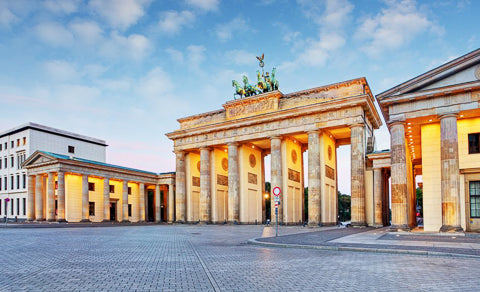 |
| Berlin - Brandenburg Gate. |
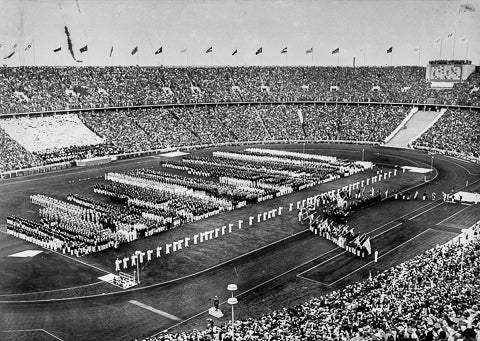 |
| Opening Ceremony 1936 Berlin Summer Olympic Games |
 |
| 1936 Berlin Olympic Games - Katharine Connal (Britain) Javelin (3rd from left). |
 |
| Take a day trip to Potsdam - an UNESCO site. |
Day 14-15-16 Berlin
(Note: Added an extra day in Berlin.)
Note: Pre purchase a Berlin Welcome Card for public transport and entry discounts to sites.
Note: Check out Berlin central train station to be familiar with access to platforms with the bikes. Pre book train tickets to Frankfurt and Sonthofen.
Olympiapark Berlin - Berlin Olympics 1/8/1936 to 16/8/1936. Guided tours for access to all areas. Bell Tower - Olympia Glockenturm (extra cost but good view). Access on U2 on U-Bahn Line or S9 on S-Bahn Line. The abandoned remains of Hitler's Olympic Village, at Wustermark, which hosted 4000 athletes "Village of Peace" where each hut named after a German town. Hitler tried to forbid Jews and black people from competing - Jesse Owens (USA) defied this with his 4 Olympic Gold Medals. One room in the village has been restored as the Jesse Owens room. Guided tours only. Note only 3.5km from Spandau.
Cycle to explore the Spandau borough with parks, waterways and the Spandau old town with half-timbered houses. The Zitadelle Berlin (Citadel); cobbled streets and alleyways of the Kolk quarter. Find the manor park at Gutspark Neu Kladow, set on the shores of the River Havel and Gutspark Groß Glienicke manor park and grounds set on the shores of a lake. In the post-war years, the border between West and East Germany ran through the centre of the lake and the park – the remains of the border complex still in place. (Check out the Komoot Bike tour of Spandau). Spandau Brewery could be a good resting place at the end of this day.
The Berlin Wall Memorial is the central memorial site of German division, located in the middle of the capital. Situated at the historic site on Bernauer Strasse, it extends along 1.4 kilometres of the former border strip. The memorial contains the last piece of Berlin Wall with the preserved grounds behind it and is thus able to convey an impression of how the border fortifications developed until the end of the 1980s. The Berlin Wall was constructed overnight on 12/8/1961 (to stop defectors from East to West) and brought down on 9/11/1989. Germany was united on 3/10/1990. After WWII Germany had been divided into The FRG (Federal Republic of Germany - West) and the GDR (German Democratic Republic - East). The inner border was closed in 1952.
A day trip to Potsdam (25km from Berlin) which is the capital of Brandenburg and on the banks of the Havel River. Sanssouci Palace; Sanssouci Park is a UNESCO World Heritage Site; the remaining 3 (of 5) city gates; the Dutch Quarter; the Bridge of Spies - Glienicker Brücke; Gedenkstätte Lindenstraße memorial (former political prison used by the Nazis, the Soviets and the East German Stasi police); the two central historic market squares the Alter Markt and opposite, behind a row of houses the Neuer Markt; shopping district on Brandenburgerstraße.
Other sites to visit: Brandenburg Gate; "The Bunker"; Berliner Unterwelten (Underground); Bikini Berlin (original mall concept - wooden pop up shops and food stalls - near the zoo); Holzmarkt on River Spree (food, studios, beer); Tempelhof Airport (Berlin Airlifts 1948/49); Jewish Museum; Berlin Cathedral; Reichstag Building; Potsdamer Platz; Kurfürstendamm (shopping boulevard); Gendarmenmarkt (beautiful square with opera house and churches); Grunewald Forest; Charlottenburg Palace; Volkspark Friedrichshain, DDR Museum. Berlin on Bike - Kreuzberg & Friedrichshain - street art & graffiti.
Day 17 Berlin to Frankfurt (Train)
Berlin Central Station - Berlin Hauptbahnhof (Hbf): 5 levels. Lowest level tracks 1-8; Concourse below street is the U-bahn/Metro; street level is main board and information; Concourse above street is main ticket desk; upper level tracks 11-16.
Train to Frankfurt about 5 hours. Be prepared for train change. Check bikes in. Pre book tickets to ensure which trains we can use. Book train, bikes and reserve seats. Bicycles can only go on long-distance trains that can accommodate bicycles. Bikes cannot go on all ICE (InterCityExpress fast trains). These trains are marked as having bicycle capacity. You will need to purchase a long-distance bicycle ticket and a bicycle space reservation. Up to 5 people can easily book the bike tickets (including parking space reservation) online together with the ticket.
Booking in a train station: General assistance go to a “Service Point” kiosk. The ticket counters are called Reise Centrum. If you purchase a ticket at the Reise Centrum, they cost a bit more than the same ticket from an automat. Using the automat: Push the button for Sprache and select the language.
Where to catch the trains: The German word for track/platform is Gleis. They are numbered and there is a number on your ticket. Arrival and departure is Ankunft and Abfahrt, respectively.
Bookings: On bahn.de and in the DB Navigator app, search specifically for connections where you can take your bike with you. Search for train connections in our "Advanced search options" select the option "Take a bicycle". You can then select exclusively from trains which transport bicycles.
Enter the number of travellers and select a connection.
After making your reservation choices, you can complete the booking process. You have the option of choosing between the online ticket for printing out at home or having your ticket sent by post for a fee.
The number of the coach in which the bicycle compartment with your bicycle reservation is located is printed on your ticket. Use only the bicycle holder which is reserved for you.
You will receive a bicycle ticket slip together with your rail ticket which has to be attached to your bicycle in a place where it can be easily seen (ideally on the handlebars). The slip contains information about your journey with the bicycle.
Check out Frankfurt main station on arrival. Frankfurt (Main) Hauptbahnhof (Hbf).
Stay 3 nights: Hotel Diplomat, Ostendstrasse 24-26, Ostend, Frankfurt am Main, Germany.
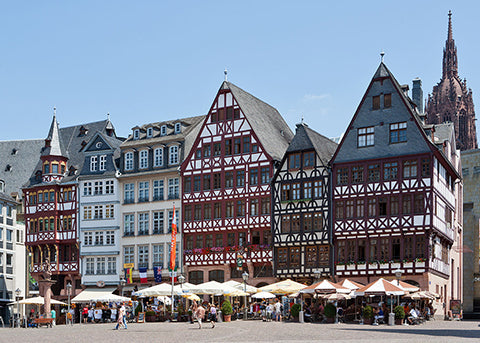 |
Day 18 - 19 Frankfurt
Frankfurt is culturally, ethnically, and religiously diverse, with half of its population, and a majority of young people, having a migration background. A quarter of the population consists of foreign nationals.
While the rest of Germany’s inhabitants are passionate beer drinkers, Frankfurt locals often come together over a glass of Äppelwoi – their take on cider. The taste is more tart and sour, but also refreshing. The Sachsenhausen district of Frankfurt is home to some traditional locales which serve the beverage in the typical Schoppen glass.
A traditional meal is Frankfurter Rippchen, which are cured and slow-cooked pork cutlets served hot with Sauerkraut, potato mash and mustard.
Gref Völsing opened its doors in 1894. Their home recipe for beef sausage is the local speciality with cult status. The consensus is that the Völsing Rindswurst is the best you can get.
German sausages make the list of the top local specialities. Frankfurter, as they’re commonly called, distinguish themselves from most of their popular cousins through several factors. The pork sausages are comparatively long and cooked in boiling water for a few minutes before served with a slice of white bread and mustard and horseradish.
Romerplatz - The historic centre of Frankfurt’s Old Town is a reconstruction and imitation of architectural styles. WWII bombings rocked these buildings to their foundations, but were reconstructed with enormous precision using their medieval maps and plans.
Opera House - “Germany’s most beautiful ruin.” This moniker fits the Opera House nicely. Restoration has returned it to its former glory.
Frankfurt Old City - A jumble of shops and restaurants line Old Town's serpentine streets. The shops here run the gamut from kitsch to traditional, most of which fall below the city's colourful, interior-lit flats. Get "wurst" on Fressgasse, a street-full of German fare - 'gasse' means alleyway; 'fressen' means to stuff your face.
Family connections: The British Visa Section operated from Zeppelinallee 47, Frankfurt am Main, Germany. This was the 'cover' office from which Jen's father communicated with the CIO network of agents during the Cold War.
Day 20 Frankfurt to Sonthofen
Frankfurt (Main) Hauptbahnhof (Hbf). By train Frankfurt to Sonthofen. Make bookings for the bikes in advance.
Meet up with friends Emilie & Jurgen (Jack) and their 3 children.
Stay: With Emilie & Jurgen 2 nights.
Day 21 Sonthofen
Walk up the stream to the dairy & cheese shop.
Note: From here little has been planned. We will add to the research on this section when we can actually travel.
Day 22 Sonthofen to Mindelhei
Day 9 of cycle 72km. Time to ride again.
Day 23 Mindelhei to Augsburg
Day 10 of cycle 62km. This route takes us along the "Romantic Road".
Stay 2 nights.
Day 24 Augsburg
Explore Augsburg.
Day 25 Augsburg to Eichstatt
Day 11 of cycle 87 km. Hop tour.
Day 26 Eichstatt to Bad Abbach
Day 12 of cycle 83km. Confluence of Danube & Naab Rivers.
Stay 2 nights or reduce to 1 night.
Day 27 Bad Abbach
Day 13 of cycle. Optional cycle to Regensberg.
Day 28 Bad Abbach to Viechtach
Day 14 of cycle 94km. Stay somewhere around here.
Day 29, 30, 31 Viechtach to Sušice or nearby.
Note Added 2 nights to allow hiking and exploring Sumava National Park.
Day 15 of cycle 74km. Cross from Germany into Czech Republic at Bayerisch Eisenstein (Germany) and Železná Ruda (Czech) - now twin towns where the railway station is split by the border.
Make sure we take in some of the Šumava National Park. The deep forests on the Czech-Bavarian border are so vast as to form the largest forested area in Europe. Forests, glacial lakes and peat bogs. Kvilda Mountain Village trails lead to Antýgl, Povydří or Jezerní slať. Modrava - walk the River Vydra (Otter)- start at Antýgl and follow the nature trail to the Čeněk Sawmill and further.
Sušice on the Otava River. Solo match factory. 8th C gold mining.
Day 32 Sušice to Kamýk nad Vltavou
Day 16 of cycle 86km.
Velhartice hrad (13thC) - north west of Susice.
Kamýk nad Vltavou - on the Vltava River. Castle ruins.
Day 33 Kamýk nad Vltavou to Prague
Day 17 of cycle 69km. Mostly on the bike path into Prague.
Stay: Neklanova Apartments, 3 Neklanova, Prague 2.
Days 34 & 35 Prague
Continue to explore Prague.
Walk to Slovanský ostrov (Slavonic Island) with neo-Renaissance Žofín Palace - a traditional venue for balls and concerts - enjoy a drink at the pontoon bar.
Try to catch a Smetana concert of Má vlast (My Homeland). Bedřich Smetana is regarded as the father of Czech music. Other favourites to look out for: Symphony No. 9 "From the New World", by Antonin Dvořák; the Slavonic Dances by Dvořák and the Hungarian Dances by Brahms.
Pre book taxi to airport.
Day 36 Prague
Depart Prague. Arrive Perth.
Meanwhile keep the dreams alive. Please comment below if you have any suggestions to add to this trip.
Jen & Greg July 2020.
Extra Notes:
Berlin Summer Olympics August 1936: A huge propaganda machine for Hitler. A Showpiece of German superiority - the biggest and the best, and an illusion that all was well, with the removal from the sight of visiting Olympians of people and things they weren't to see. New German citizenship laws in place, the Jews, the Gypsies and other 'undesirables' had been 'removed', the media was controlled. From 1933, the development of the 325 acre site of the Reichssportfield complex. A main stadium large enough to accommodate 110,000 people plus supporting stadiums for other sports. Much of the building done by hand to employ thousands of workers over a number of years. The symbol of the Games, the great bell, housed in the bell tower, inscribed with "Ich rufe die Jugend der Welt!" ("I Summon the Youth of the World!") between two swastikas.
CCG/BE: The Control Commission of Germany (British Element) (CCG/BE) was a part military, part civilian organisation established in 1945 and had responsibility for governing the British Zone of Germany following the end of World War II. It was part of the overall Allied Control Council of the four powers. The three western zones were merged to form the Federal Republic of Germany (FRG) in May 1949 and in October 1949 the soviets formed the German Democratic Republic (GDR). In the west, the occupation continued until 5 May 1955 and the western occupation zones ceased to exist.
The Berlin Blockade: Berlin 1948: June 24, 1948 to May 12, 1949. The Berlin Blockade was an attempt in 1948 by the Soviet Union to limit the ability of the United States, Great Britain and France to travel to their sectors of Berlin, which lay within Russian-occupied East Germany. They blocked all rail, road and canal access to the western zones of Berlin trapping 2.5million civilians in an island cut off from electricity, food, coal and other supplies. The western powers maintained control of three 20 mile wide air corridors from West Germany into West Berlin, carried out an airlift that lasted for 11 months to deliver vital supplies to West Berlin. Cargo planes from Western Europe delivered to the Tempelhof (in the American sector), Gatow (in the British sector) and Tegel (in the French sector) airfields in West Berlin, delivering up to about 8,000 tons of supplies per day.
Due to the success of the airlift the Soviets lifted the blockade on 12th May 1949, but the division between east and west had hardened. The airlift continued until September to stockpile supplies. This was the first major conflict of the Cold War.
With different agendas, the Soviet Union wanted to punish Germany economically, forcing the country to pay war reparations and contribute its industrial technology to help postwar Soviet recovery. On the other hand, the Allies saw Germany’s economic recovery as crucial to preserving it as a democratic buffer against the spread of communism from Eastern Europe, over which Stalin had consolidated Soviet influence.
The Spandau Prison was totally demolished in 1987 after the death of its final inmate Rudolf Hess. The site is now a shopping centre (the abandoned Britannia Centre) on corner of Wilhelmstrasse and Gatower Strasse. After WWII the prison fell in the British Sector of what became West Berlin but it was operated by the Four-Power Authorities to house the Nazi war criminals sentenced to imprisonment at the Nuremberg Trials.
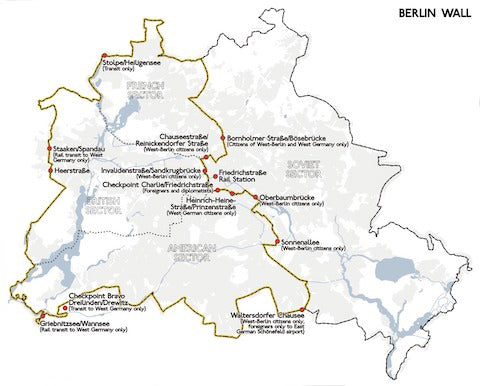 |
| The Sectors of Berlin and the Crossing Points between West and East. |
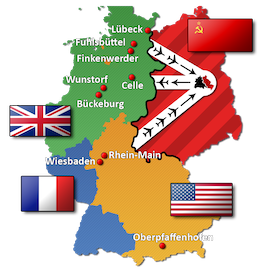 |
|
The western sectors of Germany and the air corridors used during the Berlin Airlift to supply West Berlin during the Berlin Blockade. |

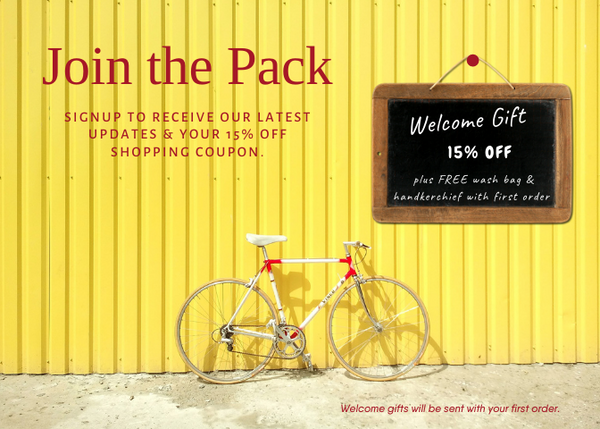
0 comments